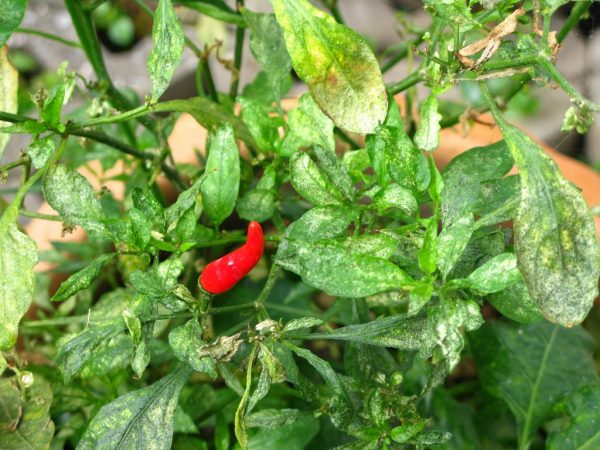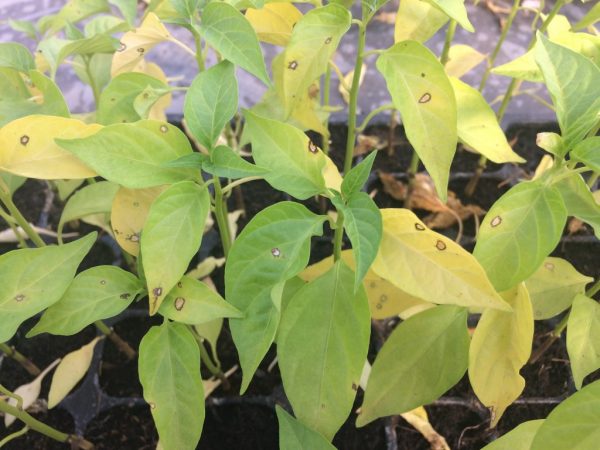Diseases of sweet pepper and methods of dealing with them
Pepper is one of the most delicate vegetable crops. It is not resistant to disease and pest attacks. Sweet pepper diseases provoke poor growth and low yields. To combat them, you need to know which remedies help with a particular disease.

Diseases of sweet pepper and methods of dealing with them
Diseases of sweet pepper
Sweet peppers have many ailments that affect the health of plants. Gardeners have researched their vegetables for viruses and diseases over the years and have bred many species.
Fusarium and sclerocinia
These diseases are caused by fungi, they can persist in the ground for a long time and infect plants. These diseases of sweet pepper are universal, because they can attack bushes at the seedling stage, when vegetables have already grown, as well as in greenhouses or on open ground.
The most important symptom of such diseases is unreasonable wilting. Usually it settles in the roots and moves to the stem, where it acts as a "plug" in the water supply system.
Late blight
This ailment is almost identical to late blight on tomatoes. Late blight affects the bush and black spots form on the stem, leaves and fruits.
The affected tissues rapidly increase in size and become denser. It can also be noted that hybrid varieties suffer from late blight much less often.
Blackleg
A disease that occurs from waterlogging of the soil, a sharp change in temperature, frost, or, most importantly, dense planting of seedlings.
The root system rots, the lower part of the stem also begins to blacken and rot, and eventually dry out.
Bronze (spotted wilt)
First, spots appear on the leaves, which are bronze, purple and dirty red. Then brown and black spots appear, and they pass to the fruit.
Fruits begin to develop light brown and yellow spots near the stalk, and as a result, the top of the fruit rots and dies off.
Cladosporium
When exposed to this disease, the leaves are covered with light yellow spots, which then develop into a dark bloom. Fruit ovaries and stalks stop development and fall off.
The disease begins to manifest itself in the lower part, and then spreads to the whole plant. Those bushes that are affected, in most cases, die.
Black bacterial spot
This dangerous disease can spend a long time in the soil and only then begin to attack vegetables. It manifests itself in the form of small spots on the leaves, which grow very quickly. As it grows, the spots turn into bumps on foliage and fruits.
Over time, ulcers appear on the vegetables, from which the bush dies. The infection is usually spread by wind, water and insects. And the cause of the occurrence can be damage to the leaves or stem.
Mosaic (mosaic)

Disease from leaves can spread to fruits
A disease that mostly affects the leaves. The foliage is deformed and covered with many light spots. Over time, it can transfer to fruits, on which yellow marks appear.
The disease enters peppers through damaged stem and leaf tissues, and can persist for a long time in the soil or seeds. It is also carried by aphids, mites and soil nematodes.
Rot gray
This particular fruit rot is caused by a fungus that “comes to life during the rainy season. Through waterlogging or long rains, the soil cannot withstand, and the disease begins to develop on the fruits.
Subsequently, the fruits of the pepper can become covered with gray mold or rot. The lesion develops very quickly and at high humidity, it can "eat" a vegetable in a few days.
Alternaria
If in the region where the pepper grows, frequent temperature drops and dry weather are possible, then the bushes can be attacked by Alternaria. This is a fungal disease that first affects the leaves, they become covered with dark spots.
After the foliage, the disease passes to the fruit, watery spots appear, after which a dark bloom appears. Vegetables can be hit from the inside, but they won't be visible from the outside.
Litracnose
The disease affects the roots and stems. It is very similar in appearance to the top rot.
The roots and base of the stem are covered with dark brown spots. Pepper does not grow well, watery spots appear on the fruit. As a result, vegetables dry out, curl and fall off.
Verticillosis (wilting)
A fungal disease that persists in the soil and manifests itself in the middle of summer. It penetrates into the plant through cuts or wounds in the roots that have arisen during digging or planting.
The disease very quickly affects the stems, leaves and ovaries on the bushes. The foliage curls, withers and becomes brown. In most cases, vegetables stop growing, dry out and die within a few days.
Phytoplasmosis
A dangerous disease that appears at the end of May, and its main carrier is the cicada. The disease affects the entire plant, at first the roots rot, the bush does not grow to the required size and turns yellow.
The leaves harden, become smaller and curl. The fruits become smaller in size, lose their taste and color. Usually, after an attack of the disease, the bush dries up.
Pillar

Insects are the cause of infection
A disease caused by a virus originating from perennial weeds. It is carried by insect pests - cicadas.
On the bushes, the disease is manifested by yellowing and drying of the leaves. The pepper stops growing and the fruit becomes deformed.
Putrefactive diseases
Top rot
One of the most common diseases that affects peppers most often. The main symptom is dark, black or shiny deep spots on the fruit, starting at the peduncle.
The disease is caused by an excess of trace elements such as nitrogen and calcium, as well as a lack of moisture. The fruits rot right on the bushes and fall to the ground before they ripen.
White rot (sclerotinosis)
A disease that is caused by a fungus and manifests itself as a white bloom on the stem, near the root. The bush withers, turns yellow and dries. After the stem, the disease spreads to the fruit, which affects the inside with black spots.
The vegetables become covered with dark seals, become watery and soft, and a white coating appears on the skin. If the pathogen hits the ground, it infects all other plants.
Disease control methods
Since all diseases are divided into different categories: fungal or viral, complex or simple. And the fight against diseases of sweet pepper will be different.
Plant protection, as well as the fight against diseases, must necessarily be comprehensive:
- if the plant is already affected, you need to cut off all diseased parts or remove the entire bush;
- if the plant is planted in a greenhouse, then sudden changes in temperature should not be allowed;
- if the seedlings are planted in open ground or in a greenhouse, it is necessary to prevent waterlogging of the soil;
- fertilizers should be applied regularly and in moderation;
- before germinating seeds, they must be treated with a solution of potassium permanganate with water for 20 minutes, and then rinsed under running water;
- with late blight, vegetables are sprayed with a 1% solution of Bordeaux liquid;
- for the prevention of mosaics, seedlings are treated with water and milk once a week;
- when a black leg appears, the soil is dried, loosening is carried out and wood ash is added to the soil;
- when apical rot appears, the bushes must be treated with a solution of potassium nitrate;
- if white rot appears, then the bush must be watered with warm water, and all diseased leaves and plants must be removed;
- after the season, you need, at least a year, not to plant other vegetables, and the same peppers, in place of the affected plants;
To prevent diseases even from appearing, you need to follow simple preventive measures.
You need to know and apply the planting rules, choose disease-resistant varieties of vegetables, make the necessary fertilizing and increase the immunity of plants with the help of specialized chemicals.
Conclusion
If you know the main features of the diseases that affect sweet peppers, their pathogens and vectors, you can protect your garden and vegetable garden. It is necessary to take into account the characteristics of each variety before planting and remember the activity of nature.
Most viruses, infections or fungi are easier to prevent with the help of preventive measures than to treat your favorite peppers for a long time and painfully. With knowledge and application of the rules of care, plants will always delight you with high yields and health.


